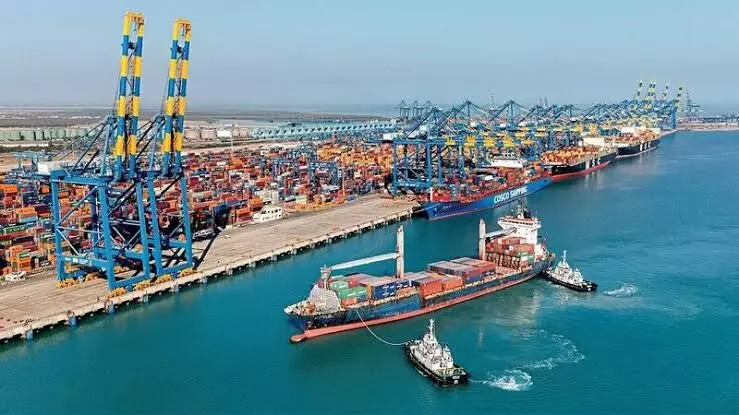India’s Haifa Gamble: Iran’s Missiles Test New Delhi’s West Asia Ambitions

India’s ambitious foray into West Asia’s strategic infrastructure has come under sudden, fiery scrutiny as Iranian missiles rained down on Israel’s Haifa Port, where Indian conglomerate Adani Group recently acquired a majority stake. This is more than a military flashpoint between Israel and Iran; it is a geopolitical shockwave that places India’s billion-dollar investments and diplomatic strategy at serious risk. With the Haifa port complex, including Israel’s largest oil refinery Bazan, now shut down due to severe damage from the strike, questions are mounting about the future of India’s engagement in the region and the sustainability of its investments under the looming shadow of war.
Union Commerce and Industry Minister Piyush Goyal recently announced India’s plan to invest up to $600 billion in the Middle East as part of the ambitious India-Middle East-Europe Economic Corridor (IMEC). This corridor, envisioned as a counterweight to China’s Belt and Road Initiative, is central to New Delhi’s strategy to increase connectivity, trade, and influence across Eurasia. Haifa Port, located on Israel’s Mediterranean coast, was supposed to be a crown jewel in this effort. In 2023, Adani Group acquired a 70 percent stake in the port, marking India’s first direct venture into operating key infrastructure in a volatile, yet economically vital region.
But this strategic breakthrough has now collided with geopolitical reality. The Iranian missile strikes, which targeted Haifa and Tel Aviv, left at least eight dead, with wide-scale destruction of critical infrastructure. At Haifa, three employees of the refinery were killed, and extensive fires engulfed the area. Though initial reports indicate that the core operations of the Adani-controlled port were not directly hit, the proximity of the attacks—striking a chemical terminal and adjacent refinery infrastructure—has made it clear that the asset now sits dangerously close to an active conflict zone.
Iran, traditionally considered a friend of India, has long maintained a nuanced relationship with New Delhi, with cooperation spanning energy, infrastructure, and connectivity projects like the Chabahar Port. Yet this missile barrage has raised complex questions. Was the strike purely a military retaliation against Israel, or did it carry a subtle message to countries like India, increasingly investing in territories Tehran views as hostile or contested? Analysts are beginning to suspect that the ramifications go beyond Israel’s security and may signal a deeper contest over influence in the Middle East, where India’s interests are now increasingly intertwined with those of the West.
The symbolism is hard to miss. Haifa was liberated from Ottoman control by Indian soldiers during World War I, in one of the last cavalry charges in modern history. The 1918 assault, led by forces from the princely states of Mysore, Hyderabad, and Jodhpur, paved the way for Allied control in the region. Over a century later, another chapter in India’s involvement in Haifa is being written—this time in the form of economic investment and infrastructure diplomacy. Yet history seems to be circling back, as the region plunges once again into conflict.
The potential fallout for Indian businesses is serious. Adani’s initial investment in Haifa is part of a larger planned $1.2 billion engagement in the IMEC initiative. Other major Indian players like Reliance Industries, Larsen & Toubro, and several infrastructure firms are also eyeing projects in the corridor. These plans now face uncertainty. If strategic assets like Haifa remain under threat, investor confidence could erode, not just for Indian firms but globally. As missiles fall and fire engulfs terminals, IMEC’s promise of secure, seamless trade routes begins to falter against the reality of geopolitical instability.
India’s challenge now is twofold. First, it must protect its citizens, companies, and investments abroad, including in conflict-prone zones. Second, it must navigate an increasingly polarised West Asia, where Iran’s aggression, Israeli retaliation, and shifting US interests create a minefield for any external player. Unlike China, which typically engages through financial instruments and avoids taking hard positions in regional conflicts, India’s model has evolved into one that combines economic presence with strategic overtones. The Haifa investment, for instance, is not merely commercial—it is a clear signal of India’s desire to shape the architecture of transcontinental logistics and geopolitics.
But this visibility comes with vulnerability. For Adani Group, Haifa may be a relatively small component in its global portfolio. It operates 13 ports across India and handles nearly 25 percent of the country’s maritime cargo. Yet Haifa is unique—it marks India’s arrival on the global stage of strategic infrastructure. Its damage, therefore, is symbolic as much as it is financial. As Iran targets deep into Israel’s northern flank, far from the conventional theatre of conflict, the risk calculus for Indian and international investors is being rewritten.
The broader implications of this moment could extend beyond regional instability. With China watching closely, the viability of India’s IMEC initiative could influence future investment patterns. If India falters in Haifa or withdraws from the region’s complex terrain, it risks ceding ground not just in West Asia, but across the entire Eurasian connectivity map. Conversely, if it chooses to remain and invest in resilience and security, it must be prepared to operate in an environment where economics and geopolitics are inseparable—and where missiles may land before memoranda of understanding are inked.
Ultimately, the Haifa strike is not just about port infrastructure. It is about India’s place in the global order, its appetite for risk, and its readiness to shoulder the burdens that come with influence. Whether India recalibrates or doubles down remains to be seen. But the message from West Asia is clear: the region may welcome investment—but it comes with no guarantees.
